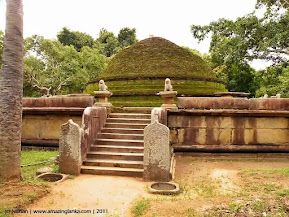Lahugala is one of the unspoiled National Parks in Sri Lanka in the Ampara District bordering Monaragala District. The Siyambalanduwa – Pottuvil Road runs on the south-eastern sector of the park. The Magul Maha Viharaya lies about 22 km off Siyambalanduwa town and about 11 km off Pottvil.
Lahugala Magul Maha Viharaya is made in the form of a pabbatha vihara architecture. Archaeologists believe that Pabbata Vihara was built by merging with a natural rock formation. These are built by arranging several rectangular building areas (courtyards) at different levels surrounded by water. In the upper courtyard itself are the four sacred buildings arranged in specific order. In the ancient architecture book ‘Manju Sri Bhashitha Vastuvidyawa” (මඤ්ජු ශ්රී භාෂිත වාස්තුවිද්යාව) written in Sanskrit, these buildings and standards are well explained.
The basic feature of these monasteries is a large rectangular precinct or sacred quadrangle that contains the four major shrines, a stupa, a bodhighara, a patimaghara, and a prasada which has been identified as the uposathaghara. Vijayaramaya, Pankuliya Asokaramaya, Pacina Tissa Pabbatha Viharaya, Puliyankulama Pabbata Viharaya (Pubbaramaya), Toluvila, and Vessagiriya are the temples of this tradition in Anuradhapura. Kaludiya Pokuna (Dhakkinagiri Viharaya) in Dambulla, Lahugala Magul Maha Viharaya, Menikdena, Pulukunava in the Gal Oya valley, a group of shrines at the foot of the rock at Sigiriya and Moragoda in Padaviya are the other provincial sites where Pabbata Vihara have been identified. (Bandaranayake, 1974).




.jpg)






.jpg)
.jpg)
.jpg)
.jpg)
.jpg)
.jpg)
.jpg)
.jpg)
.jpg)
.jpg)
